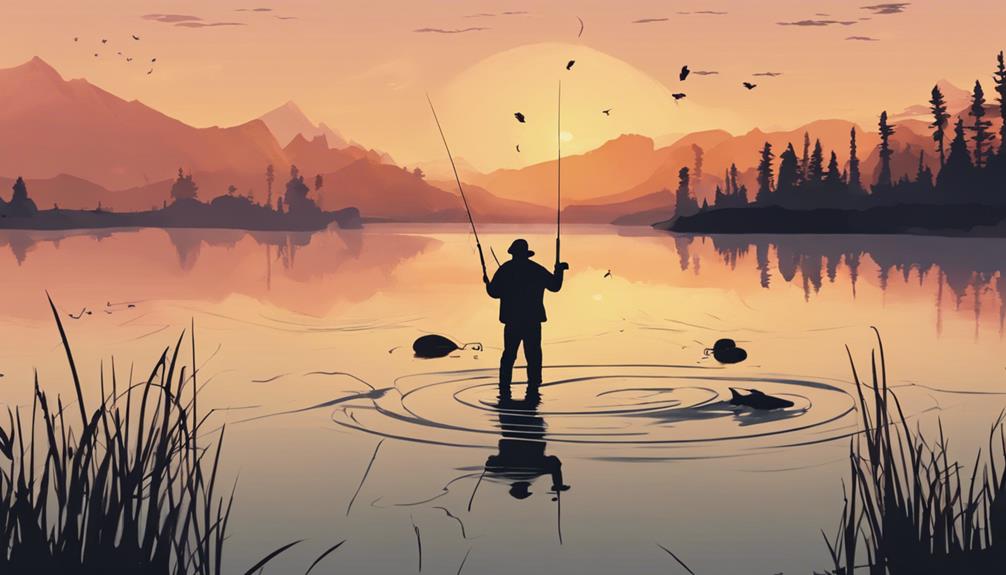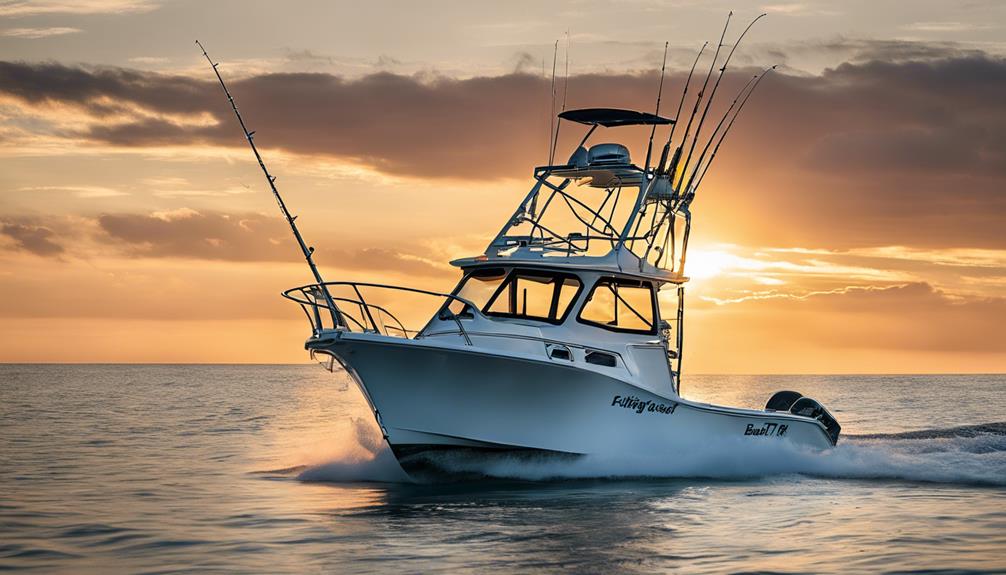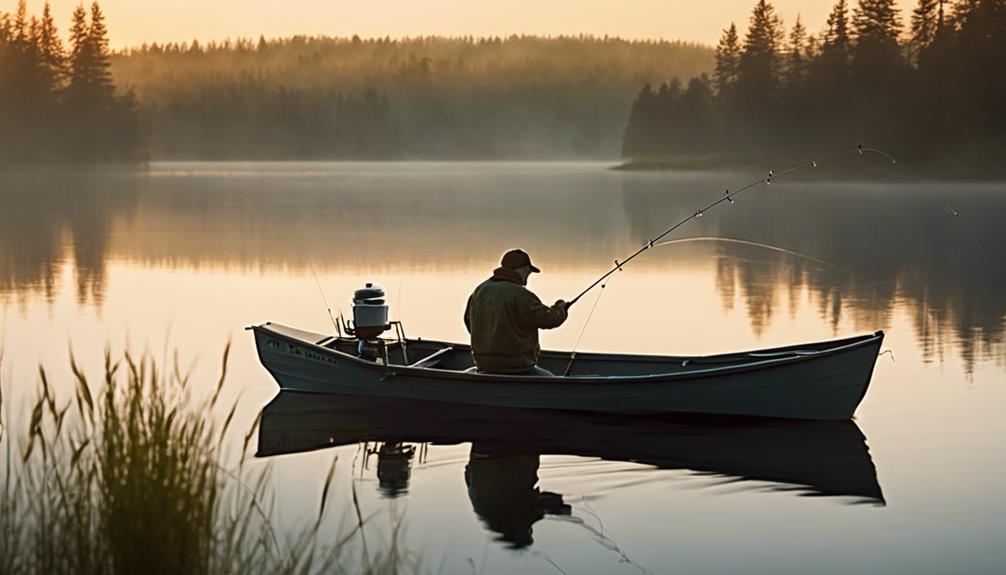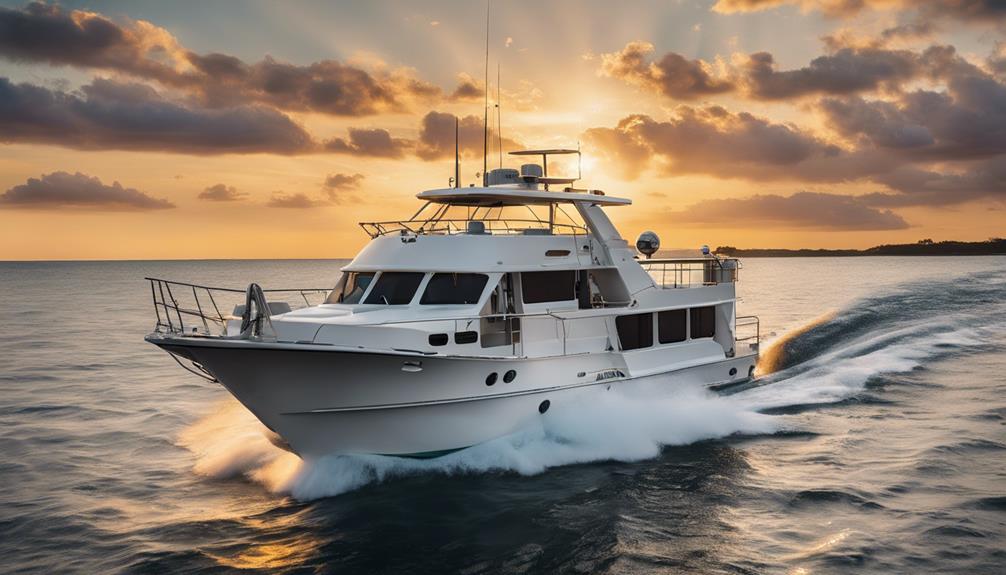Master successful bass angling by understanding bass behavior, mastering lure techniques, identifying prime habitat locations, perfecting casting, using electronics for precision, and developing a versatile tackle arsenal. Bass are structure-oriented and active during warmer months. Learn topwater lure methods like 'walk-the-dog' and adjust retrieval to trigger strikes. Focus on water depth, vegetation, and structures for ideal spots. Hone casting accuracy, adjust in windy conditions, and try various lures. Utilize sonar and GPS for precise fishing. Organize tackle for quick access with diverse options. Embrace these strategies to elevate your bass angling game to the next level.
Understanding Bass Behavior Patterns
To excel in bass angling, mastering the understanding of bass behavior patterns is essential. Bass exhibit distinct behaviors based on seasonal feeding patterns and movement. During the warmer months, bass are more active and tend to feed more frequently. They move to shallower waters in search of prey, especially during dawn and dusk when the light is low. Understanding this behavior can help you position yourself strategically to increase your chances of a successful catch.
Water temperature plays a crucial role in bass behavior. As the water temperature changes, so does the bass's activity level. In colder water, bass tend to be lethargic and less likely to chase fast-moving baits. They often move to deeper waters where the temperature is more stable. Conversely, in warmer water, bass become more active and may venture into shallower areas to feed.
Depth is another factor that influences bass behavior. Bass are structure-oriented fish and can be found near underwater structures such as rocks, logs, or vegetation. Understanding the depth at which bass are holding can help you choose the right lures and presentations to entice them to strike. By observing their movements and the depth at which they're most active, you can adjust your fishing techniques accordingly to effectively target bass in different water conditions.
Mastering Topwater Lure Techniques
Mastering topwater lure techniques requires finesse and precision to entice bass to strike on the water's surface. To achieve successful surface strikes, it's crucial to understand the art of lure retrieval. When using topwater lures, the key is to create a realistic presentation that mimics natural prey movements, triggering the bass's predatory instincts. Start by casting your lure near potential bass hideouts such as fallen trees, lily pads, or rocky structures, as these are prime locations where bass often lurk.
One effective technique is the 'walk-the-dog' retrieve. This involves gently twitching the rod tip to make the lure zig-zag back and forth on the water's surface, imitating a wounded or disoriented prey. The erratic movements draw the attention of nearby bass, enticing them to strike. Another technique is the 'pop-and-stop,' where you reel in the lure with quick jerks followed by brief pauses. This action creates splashes and ripples, simulating a struggling insect or small fish.
Remember to vary your retrieval speed and cadence to determine what triggers the most strikes. Observing how bass react to different movements will help you refine your technique. Be attentive to subtle cues like swirls or splashes near your lure, as they may indicate bass preparing to strike. By mastering these topwater lure techniques, you can increase your chances of landing that elusive trophy bass.
Identifying Prime Bass Habitat Locations
Identifying prime bass habitat locations involves closely examining the underwater terrain, vegetation, and structural features that attract and sustain bass populations in a given body of water. To pinpoint these ideal spots, focus on water depth and vegetation cover. Bass are often found near structures such as submerged logs, rock formations, or aquatic plants that provide cover and ambush points for feeding.
Water depth plays a crucial role in determining bass habitat. Different species of bass prefer varying depths, but as a general rule, they tend to frequent areas where the water is neither too shallow nor too deep. Look for drop-offs, points, and ledges where bass can move between shallower and deeper waters with ease. These transition zones are often productive fishing spots.
In terms of vegetation cover, bass are drawn to areas with abundant aquatic plants like lily pads, hydrilla, or submerged grass. These plants offer protection, oxygenation, and serve as hunting grounds for bass seeking prey. Target areas where vegetation meets open water, creating a natural boundary that bass use to hide and feed.
Perfecting the Art of Casting
Honing your casting technique is essential for successful bass angling, requiring precision and finesse to accurately deliver your lure to strategic locations. Line control plays a crucial role in casting accuracy. Make sure to keep your line taut throughout the cast to ensure a smooth and accurate delivery of your lure. Avoid slack in the line as it can result in decreased accuracy and control over your presentation.
When casting in windy conditions, understanding and mitigating wind resistance is key. Adjust your casting angle and power to compensate for the wind, allowing your lure to reach its intended target without being significantly affected by the wind. Additionally, selecting the right lure for the conditions can enhance your casting accuracy. Lighter lures are more susceptible to wind interference, so opt for heavier lures in windy situations to maintain control and precision in your casts.
Lure selection also plays a vital role in perfecting your casting technique. Different lures have varying aerodynamic properties that can impact your casting distance and accuracy. Experiment with different lure types and sizes to find the one that best suits your casting style and fishing environment. By mastering line control, adjusting for wind resistance, and selecting the right lure, you can significantly improve your casting accuracy and ultimately increase your chances of a successful bass angling experience.
Utilizing Electronics for Precision Fishing
To enhance your precision in fishing, incorporating electronic devices can provide valuable assistance in locating and targeting bass effectively. Sonar technology and GPS navigation systems are indispensable tools for bass anglers looking to up their game. Sonar technology allows you to see beneath the water's surface, identifying structures where bass might be hiding. By interpreting the sonar readings, you can pinpoint the best spots to cast your line and increase your chances of a successful catch.
Depth finders and fish finders are also essential electronics for bass anglers. Depth finders help you determine the depth of the water you're fishing in, allowing you to adjust your bait or lure presentation accordingly. Fish finders, on the other hand, use sonar to detect fish underwater, giving you a real-time view of what lies beneath your boat. This information is invaluable in helping you target bass and understand their behavior patterns.
GPS navigation systems complement these technologies by allowing you to mark productive fishing spots and navigate back to them with ease. By creating waypoints for successful locations, you can build a database of prime fishing spots for future trips.
Incorporating these electronic devices into your fishing arsenal can significantly improve your precision and success on the water. Familiarize yourself with how to use these tools effectively, and watch your bass angling skills reach new heights.
Developing a Versatile Tackle Arsenal
Develop a diverse assortment of fishing gear to maximize your chances of success in varying angling conditions. Having a versatile tackle arsenal is essential for adapting to different situations on the water. Here are some key points to consider when developing your tackle selection:
- Tackle organization: Efficiently organizing your tackle is crucial for quick access to the right gear when you need it. Consider using tackle boxes with separate compartments for different types of lures, hooks, weights, and other essentials. This will help you stay organized on the water and save time when changing setups.
- Lure selection: Having a variety of lures in your tackle box is essential for enticing bass in different conditions. Include a mix of topwater lures, crankbaits, jigs, soft plastics, and spinnerbaits to cover a range of fishing scenarios. Experimenting with different colors, sizes, and actions can help you figure out what the fish are biting on during your outing.
- Rod and reel combinations: Invest in a few different rod and reel setups to handle various fishing techniques. Match your rods and reels based on the type of fishing you plan to do, whether it's finesse techniques, flipping and pitching, or casting crankbaits. Having the right combination of gear can make a significant difference in your angling success.
Frequently Asked Questions
How Can Weather Conditions Affect Bass Behavior?
Weather conditions significantly impact bass behavior. Temperature fluctuations influence their feeding patterns, with bass becoming more active in warmer water.
Barometric pressure changes can also affect their behavior, often triggering feeding frenzies or causing them to become less active.
Additionally, weather conditions play a crucial role in bass spawning behavior, as temperature and other factors can determine when and where they spawn.
Understanding these weather influences is key to successful bass angling.
What Are the Best Colors for Topwater Lures?
When choosing the best colors for topwater lures, consider factors like water clarity, time of day, and the behavior of the bass. Opt for brighter hues in murky water and darker shades in clear conditions.
During low light periods, go for colors that offer high contrast and visibility. Vary your retrieval speed to mimic fleeing prey and trigger strikes.
Experiment with different colors and observe what works best in different situations.
Do Bass Prefer Structure or Vegetation for Habitat?
When it comes to bass habitat preferences, understanding the balance between structure and vegetation is key.
Bass behavior often varies based on their environment, but generally, they tend to gravitate towards structures like rocks, fallen trees, and submerged logs for shelter and ambush points.
However, they also rely on vegetation like grass beds and lily pads for protection and foraging opportunities.
Knowing how to locate and fish these areas effectively can greatly enhance your angling success.
What Casting Techniques Work Best in Windy Conditions?
When facing windy conditions while casting for bass, it's crucial to focus on line control and accuracy.
The wind can impact your casting distance and affect the path of your lure. To combat this, adjust your casting angle to counter wind drift and ensure accurate lure presentation.
How Do Electronics Help Locate Bass in Deep Water?
To locate bass in deep water, sonar technology and fish finders are invaluable tools. These devices use sound waves to identify underwater structures where bass might hide.
Additionally, with underwater mapping and GPS tracking, you can pinpoint exact locations where bass are more likely to be found.
Conclusion
Now that you have learned the 6 best strategies for successful bass angling, it's time to put your knowledge to the test on the water.
By understanding bass behavior patterns, mastering topwater lure techniques, identifying prime habitat locations, perfecting your casting skills, utilizing electronics, and developing a versatile tackle arsenal, you're well-equipped to reel in those big bass.
Remember, practice makes perfect, so get out there and start honing your skills for a successful angling adventure.
Happy fishing!



